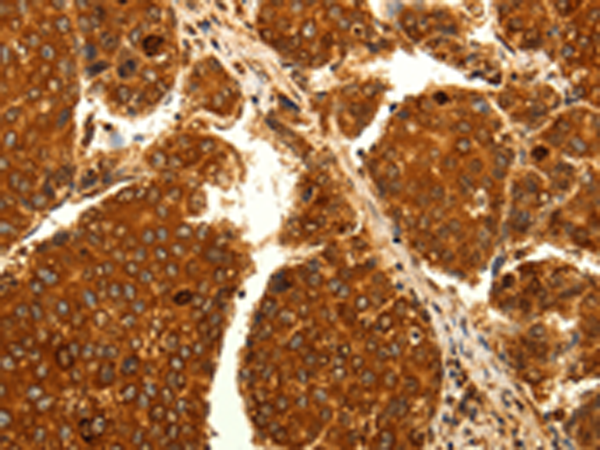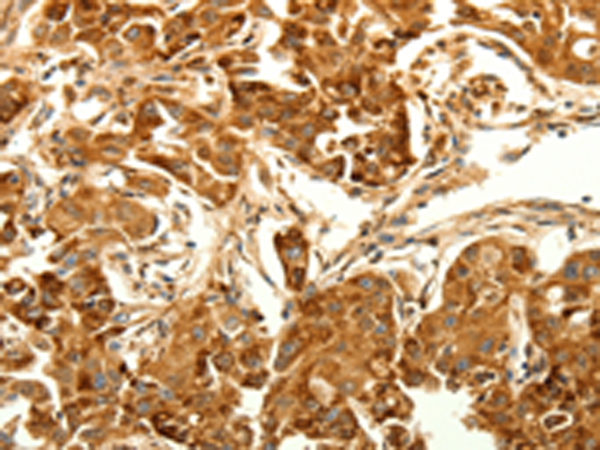

| WB | 咨询技术 | Human,Mouse,Rat |
| IF | 咨询技术 | Human,Mouse,Rat |
| IHC | 1/50-1/200 | Human,Mouse,Rat |
| ICC | 技术咨询 | Human,Mouse,Rat |
| FCM | 咨询技术 | Human,Mouse,Rat |
| Elisa | 1/2000-1/5000 | Human,Mouse,Rat |
| Aliases | LC3; LC3A; ATG8E; MAP1ALC3; MAP1BLC3 |
| Host/Isotype | Rabbit IgG |
| Antibody Type | Primary antibody |
| Storage | Store at 4°C short term. Aliquot and store at -20°C long term. Avoid freeze/thaw cycles. |
| Species Reactivity | Human, Mouse, Rat |
| Immunogen | Fusion protein of human MAP1LC3A |
| Formulation | Purified antibody in PBS with 0.05% sodium azide and 50% glycerol. |
+ +
以下是关于MAP1LC3A抗体的3篇参考文献概览:
1. **文献名称**:*LC3. a mammalian homologue of yeast Apg8p, is localized in autophagosome membranes after processing*
**作者**:Kabeya, Y., et al.
**摘要**:该研究首次描述了哺乳动物LC3蛋白(包括LC3A)在自噬过程中的作用,通过特异性抗体验证了LC3A在自噬体膜上的定位,并证明其加工形式(LC3-II)可作为自噬活动的标志物。
2. **文献名称**:*Guidelines for the use and interpretation of assays for monitoring autophagy*
**作者**:Klionsky, D.J., et al.
**摘要**:这篇权威指南汇总了自噬研究的标准方法,其中强调了MAP1LC3A抗体的应用,包括Western blot检测LC3-I向LC3-II的转化及免疫荧光显微术中的注意事项,为抗体使用的可靠性提供了依据。
3. **文献名称**:*Differential expression patterns of LC3A and LC3B in mammalian tissues*
**作者**:Tanida, I., et al.
**摘要**:研究比较了LC3A与LC3B在不同组织中的表达差异,利用特异性抗体揭示了LC3A在特定细胞类型(如神经元和肝细胞)中的富集现象,提示其功能可能与LC3B存在分化。
这些文献涵盖了LC3A抗体的开发、标准化应用及其在自噬机制研究中的关键作用。
The MAP1LC3A (microtubule-associated proteins 1A/1B light chain 3A) antibody is a key tool for studying autophagy, a cellular degradation process critical for maintaining homeostasis. MAP1LC3A, also known as LC3A, is a mammalian homolog of yeast Atg8 and exists in two forms: cytosolic LC3-I and lipidated, autophagosome-associated LC3-II. During autophagy, LC3-I is conjugated to phosphatidylethanolamine to form LC3-II, which integrates into autophagosomal membranes, making it a widely accepted marker for autophagosome formation.
Antibodies targeting MAP1LC3A are used to detect and quantify autophagy flux in various experimental models, including Western blot (WB), immunofluorescence (IF), and immunohistochemistry (IHC). They help distinguish LC3-I (∼16 kDa) from LC3-II (∼14 kDa due to faster migration on gels) and assess autophagic activity under conditions like nutrient deprivation, stress, or disease states. Researchers often pair LC3A antibodies with lysosomal inhibitors (e.g., chloroquine) to monitor autophagosome accumulation.
These antibodies are essential in studying autophagy-related pathologies, such as cancer, neurodegenerative disorders (e.g., Alzheimer’s), and infectious diseases. Commercial LC3A antibodies are typically raised in rabbits or mice against epitopes in the N-terminal or C-terminal regions, with validation in knockout controls to ensure specificity. However, users must optimize protocols (e.g., fixation methods, blocking buffers) to avoid cross-reactivity with other LC3 isoforms (LC3B, LC3C) or background noise.
×